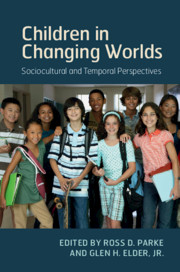Book contents
- Children in Changing Worlds
- Children in Changing Worlds
- Copyright page
- Contents
- List of Figures
- Contributor Biographies
- Preface
- Part I Theoretical and Methodological Approaches: A Cross-Disciplinary Challenge
- Part II Historical and Life Course Transitions: Economic and Demographic Change
- Part III Social, Legal, and Technological Change: Impact on Children
- Part IV Views of the Interdisciplinary Dialogue: From Developmental Science and Sociology
- Author Index
- Subject Index
- References
Part I - Theoretical and Methodological Approaches: A Cross-Disciplinary Challenge
Published online by Cambridge University Press: 18 July 2019
- Children in Changing Worlds
- Children in Changing Worlds
- Copyright page
- Contents
- List of Figures
- Contributor Biographies
- Preface
- Part I Theoretical and Methodological Approaches: A Cross-Disciplinary Challenge
- Part II Historical and Life Course Transitions: Economic and Demographic Change
- Part III Social, Legal, and Technological Change: Impact on Children
- Part IV Views of the Interdisciplinary Dialogue: From Developmental Science and Sociology
- Author Index
- Subject Index
- References
Summary
In this opening chapter we provide a chronology of the relatively recent recognition that an understanding of children’s lives across time requires that context in terms of historical time and place also needs to consider culture . Early efforts often failed to recognize this fundamental premise and instead studied children out of context.
The emergence of the life course perspective with its recognition of the centrality of changing historical contexts as necessary for an adequate understanding of children’s development was a major step forward in theorizing about children’s development. Moreover, in the past several decades, the life course perspective has also evolved and now recognizes the role of both individual and collective agency in shaping both individual outcomes and those at other levels of analysis. Moreover, as prior work has long recognized, it is increasingly accepted that secular changes co-occur and often come as a package.
For example, war, famine, migration, and economic hardship generally operate together. We also underscore the increasing appreciation of cross-disciplinary dialogue as necessary for understanding issues such as children’s genetic influences and how they are constrained in their expression by historical and environmental factors.
- Type
- Chapter
- Information
- Children in Changing WorldsSociocultural and Temporal Perspectives, pp. 1 - 22Publisher: Cambridge University PressPrint publication year: 2019



